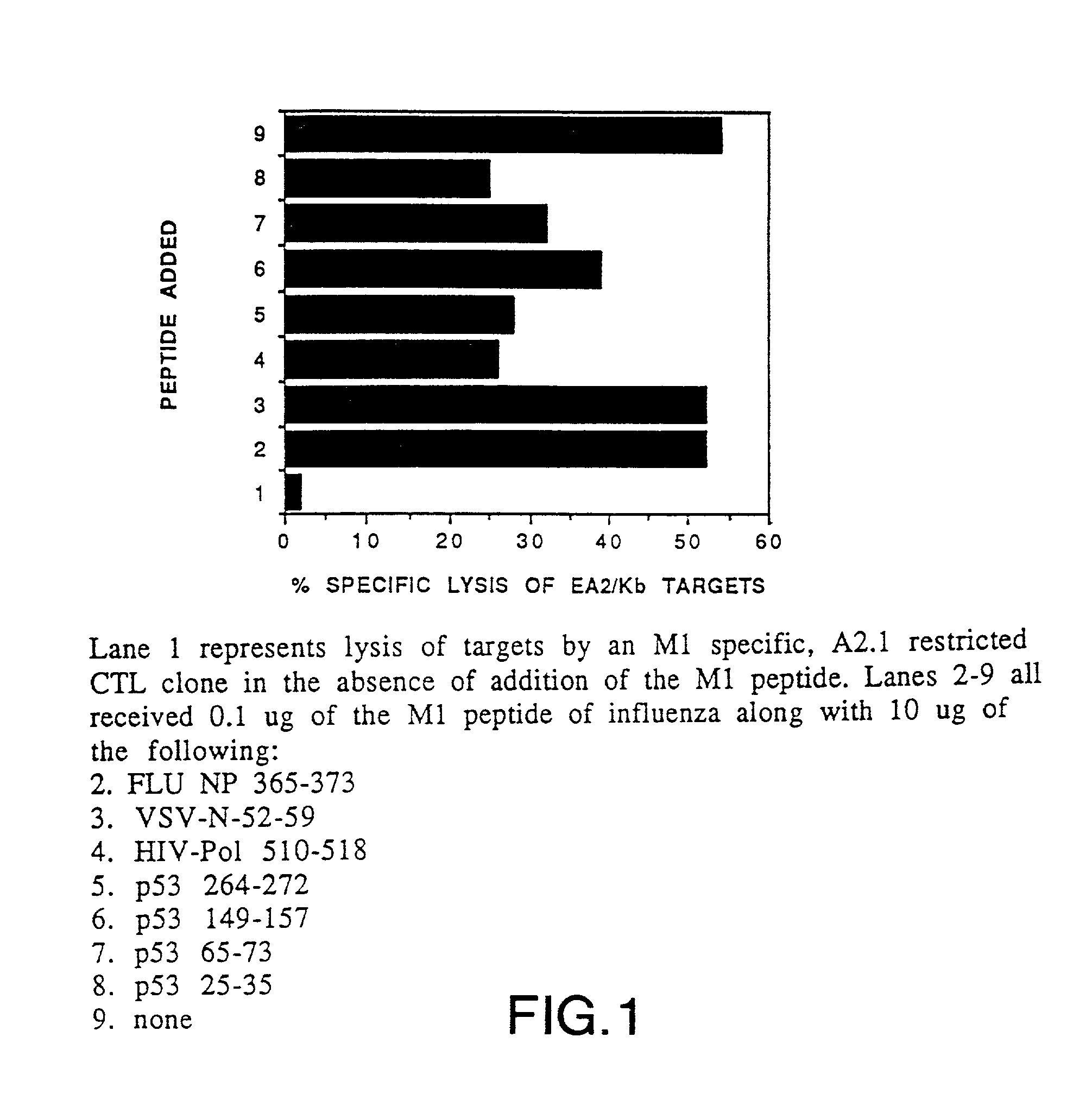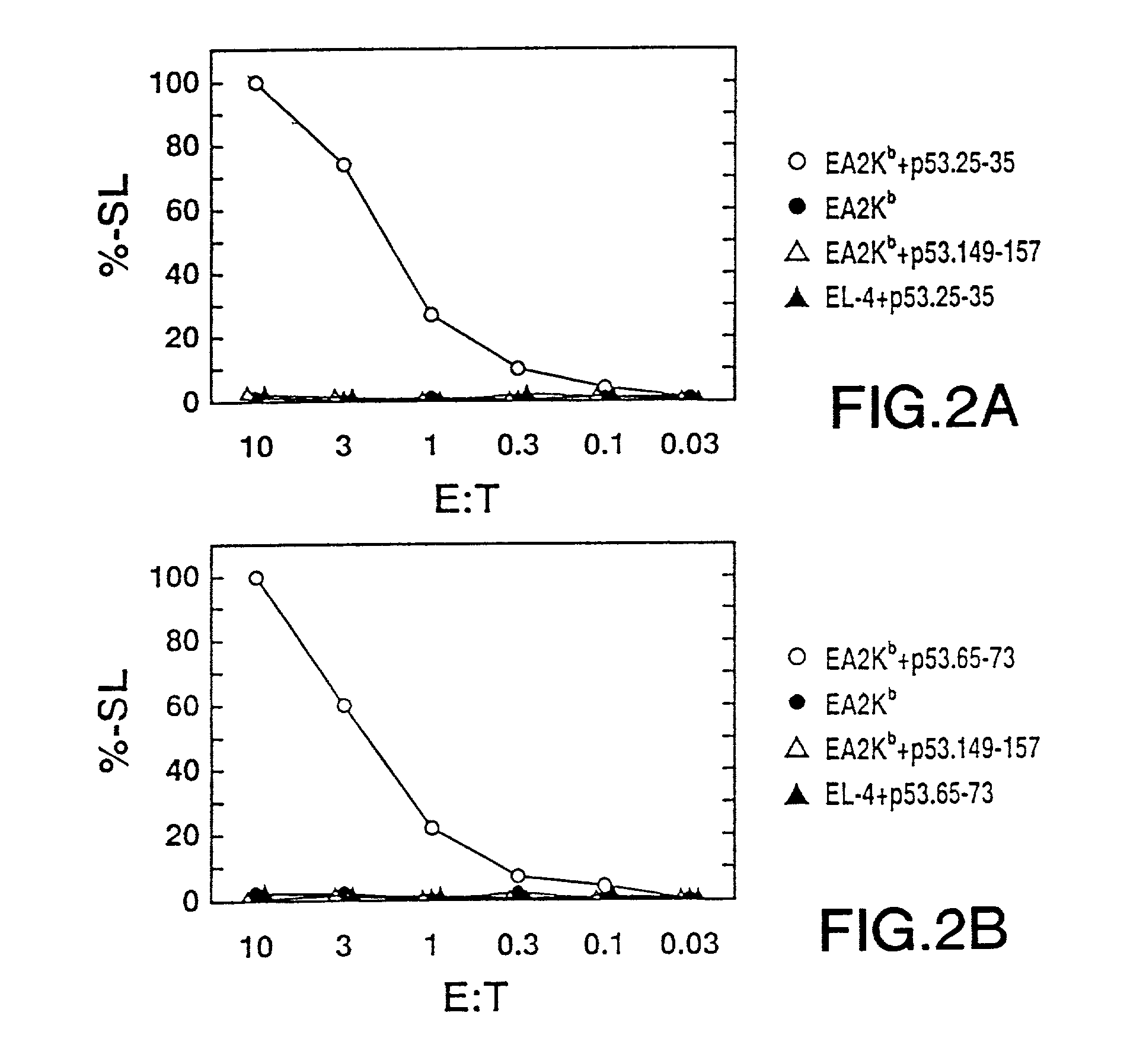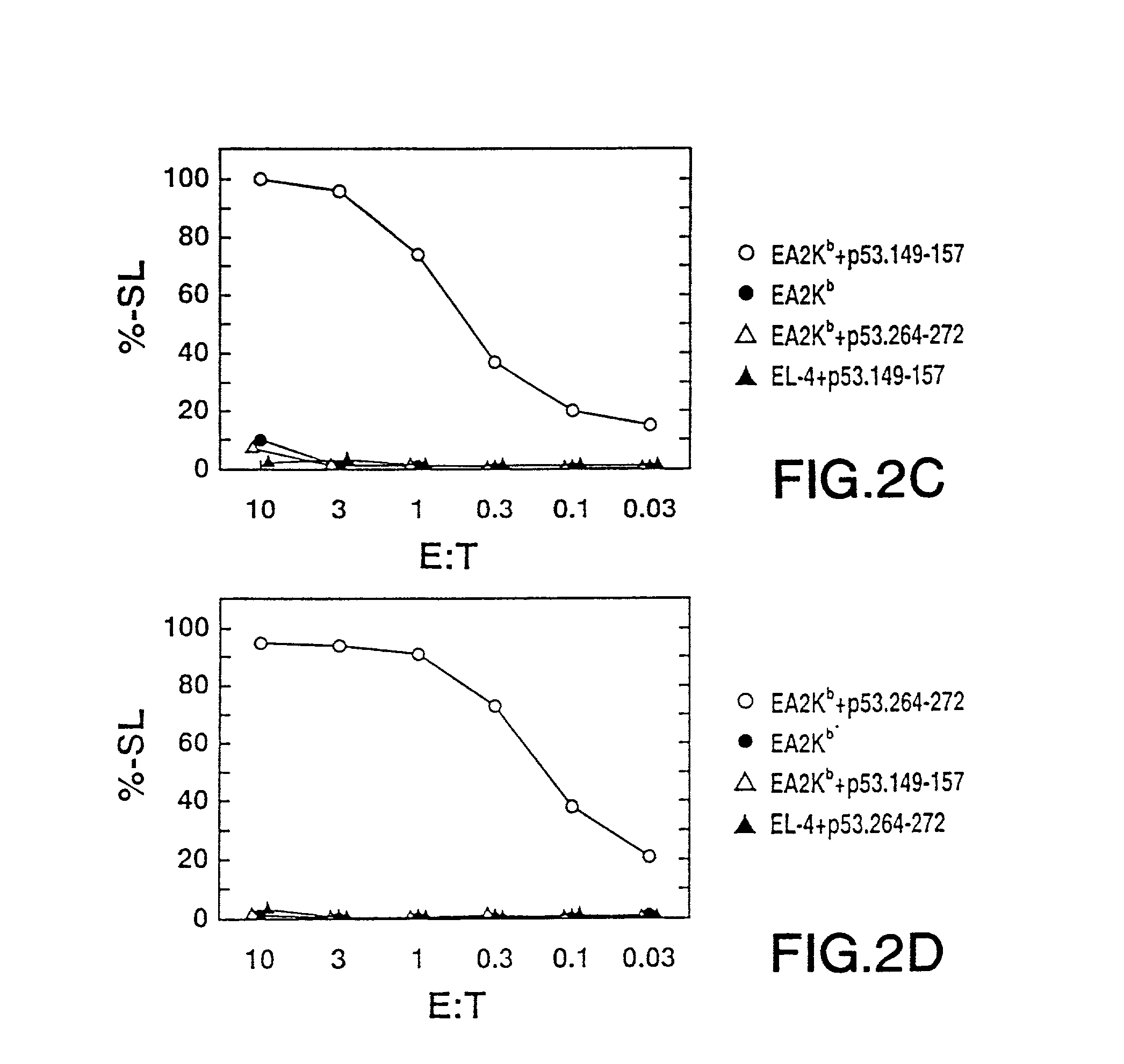In vivo activation of tumor-specific cytotoxic T cells
a cytotoxic t lymphocyte and tumor-specific technology, applied in the field of in vivo activation of tumor-specific cytotoxic t cells, can solve the problems of inability to specifically activate cytotoxic t lymphocytes, few successful attempts to eliminate viral infections, and the cost of eliminating viral infections is the accompanying loss of infected cells
- Summary
- Abstract
- Description
- Claims
- Application Information
AI Technical Summary
Benefits of technology
Problems solved by technology
Method used
Image
Examples
example 1
CTL-Mediated Lysis of Target Cells Expressing p53-Specific Peptides
A. Preparation of HLA-A2.1 / Kb-restricted p53 Peptide-Specific Cytotoxic T Lymphocytes (CTL)
[0339]Cytotoxic T lymphocytes (CTL) specific for p53 peptide were prepared by designing and synthesizing peptides derived from p53 which are capable of being bound by HLA A2.1 molecules, immunizing HLA-A2.1 / Kb (A2.1 / Kb) transgenic mice in vivo with the p53 peptide, and generating p53 peptide-specific CTL cell lines derived from the immunized transgenic mice. Details of these procedures are as outlined below.
[0340]1. Preparation of p53 Peptides
[0341]a. Peptide Design
[0342]Peptides which comprise 8 to 11 amino acid residues in length can be accommodated within the peptide binding groove of the HLA molecule. The length of the bound peptide is restricted by the interaction of the amino and carboxyl termini of the peptide with the extremities of the peptide binding groove (Madden et al., Nature 353: 321-325 (1991)). Amino acid resid...
example 2
CTL-Mediated Lysis of Target Cells Expressing Her-2 / Neu-Specific Peptides
A. CTL-Mediated Lysis of Target Cells with Bound Her-2 / Neu-Derived Peptides
[0414]Her-2 / Neu peptide-specific CTL were prepared by designing and synthesizing peptides derived from Her-2 / Neu capable of being bound by HLA A2.1 molecules, immunizing A2KbxCD8 transgenic mice in vivo with Her-2 / Neu peptides, and generating Her-2 / Neu peptide-specific CTL cell lines derived from the immunized transgenic mice.
[0415]1. Preparation of Her-2 / Neu Peptide Immunogens
[0416]Her-2 / Neu-specific peptides were designed following the same motif described for the p53 peptides (see Example 1A1a) and are listed with their respective amino acid residue positions and SEQ ID NOS in Table 3. Her-2 / Neu-specific peptides were synthesized and analyzed as described in Example 1A1b.
[0417]
TABLE 3Amino AcidAminoPeptideResidueAcid ResidueSEQDesignationPositionSequenceID NOHER-3369-377KIFGSLAFL10HER-6444-453TLQGLGISWL11HER-7773-782VMAGVGSPYV12HER-85...
example 3
CTL-Mediated Lysis of Target Cells Expressing Her-2 / Neu-Specific Peptides
A. Her-2 / Neu Peptide-Specific CTL-Mediated Lysis of Breast Carcinoma Cells
[0439]The Her-2 / Neu peptide-specific CTL prepared as described in Example 2B1 were then assayed for their ability to lyse breast carcinoma cell lines which express A2 and Her-2 / Neu.
[0440]1. Preparation of Target Cells
[0441]The breast carcinoma cell lines MCF-7 (ATCC HTB 22), MDA 23.1 (ATCC HTB 26), and MDS 435 (ATCC HTB 129) were characterized phenotypically to determine if A2 was expressed on the cell by FACS analysis using the A2-specific monoclonal antibody PA2.1 (ATCC HB 1 17). MCF-7 and MDA 23.1 express A2 (and are thus designated A2+) while MDS 435 does not express A2 (and is thus designated A2+). In addition, the cell lines were characterized for cell surface expression of Her-2 by FACS analysis with c-Neu (AB-5) monoclonal antibody (Oncogene Science, Uniondale, N.Y.). The c-Neu antibody reacts with an epitope of Her-2 / Neu on the c...
PUM
| Property | Measurement | Unit |
|---|---|---|
| time | aaaaa | aaaaa |
| concentration | aaaaa | aaaaa |
| body weight | aaaaa | aaaaa |
Abstract
Description
Claims
Application Information
 Login to View More
Login to View More - R&D
- Intellectual Property
- Life Sciences
- Materials
- Tech Scout
- Unparalleled Data Quality
- Higher Quality Content
- 60% Fewer Hallucinations
Browse by: Latest US Patents, China's latest patents, Technical Efficacy Thesaurus, Application Domain, Technology Topic, Popular Technical Reports.
© 2025 PatSnap. All rights reserved.Legal|Privacy policy|Modern Slavery Act Transparency Statement|Sitemap|About US| Contact US: help@patsnap.com



